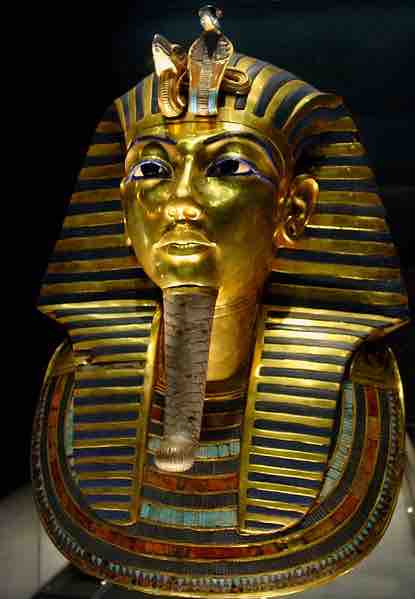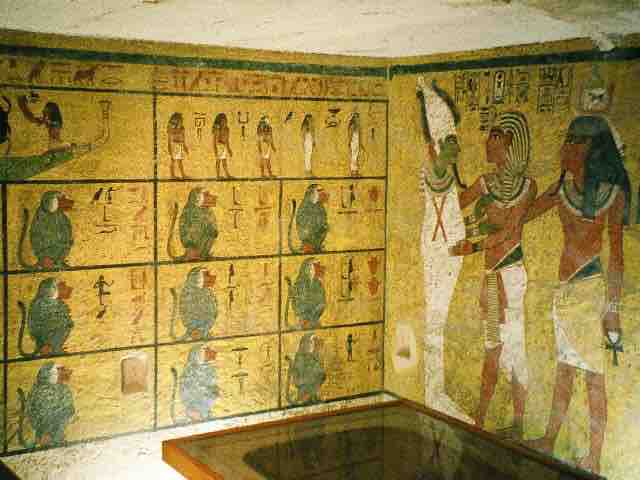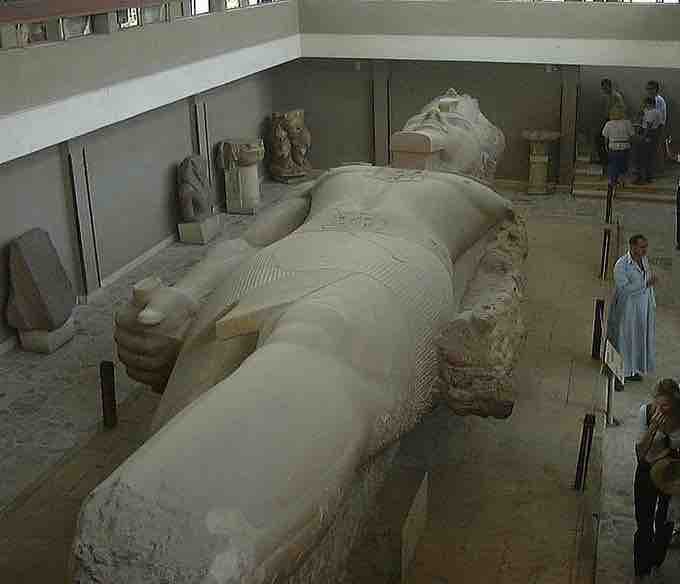Tutankhamun
Tutankhamun was an Egyptian pharaoh of the 18th dynasty, who ruled from around 1332 BC – 1323 BC. Popularly referred to as "King Tut," the boy-king took the throne when he was nine and ruled until his early death at age nineteen. Tutankhamun's significance stems from the fact that his tomb in the Valley of the Kings was discovered almost completely intact, making it the most complete ancient Egyptian royal tomb ever found. Discovered in 1922 by Howard Carter and George Herbert, his tomb, mummy, and artifacts sparked a renewed public interest in ancient Egypt .

Tuthankamen's famous burial mask, on display in the Egyptian Museum in Cairo.
King Tut's burial mask has become a popular symbol for Egypt since its discovery in his tomb in 1922.
Tutankhamun was one of the few kings worshiped as a deity through mortuary cults and temples during his lifetime. He is known for his rejection of the radical religious innovations introduced by his predecessor and father, Akhenaten. In his third regnal year, he ended the worship of the god Aten and restored the god Amun to supremacy, also changing his name from Tutankhaten to Tutankhamun. As part of this religious restoration, he initiated many building projects, including monuments and temples dedicated to Amun at Thebes and Karnak.
Tutankhamun was buried in a tomb that was small relative to his status. His death may have occurred unexpectedly, before the completion of a grander royal tomb, so that his mummy was buried in a tomb intended for someone else. His mummy still rests in his tomb in the Valley of the Kings, though is now on display in a climate-controlled glass box rather than his original golden sarcophagus . Relics and artifacts from his tomb, including his pectoral jewels and a red granite lion, are among the most traveled artifacts in the world.

Painted walls in the burial chamber of Tutankhamun's tomb, Valley of the Kings, Egypt
Tutankhamun's burial chamber contained beautiful works of art, text and hieroglyphics.
Tutankhamun seems to have faded from public consciousness in Ancient Egypt within a short time after his death; he remained virtually unknown until the 1920s. His tomb was robbed at least twice shortly after his initial burial. Eventually the location of the tomb was forgotten, after it was buried and lost under stone chips from subsequent tombs that were either dumped there or washed there by floods. In the years that followed, huts for workers were built over the tomb entrance, the builders clearly not aware of what lay beneath. When the Valley of the Kings burials were systematically dismantled at the end of the 20th Dynasty the burial of Tutankhamun was somehow overlooked.
Ramses II
Ramses II (also spelled Ramesses and referred to as Ramesses the Great), was the third Egyptian pharaoh of the 19th dynasty; he reigned from 1279 - 1213 BC. He is often regarded as the greatest, most celebrated, and most powerful pharaoh of the Egyptian Empire, known for his military expeditions and his building of cities, temples, and monuments.
The early part of his reign focused on architectural building projects throughout Egypt and Nubia. His cartouches - hieroglyphs depicting his royal name - are prominently displayed on marker stones, statues, remains of palaces and temples, and even in buildings that he did not actually construct. He covered the land from the Delta to Nubia with buildings in a way no king before him had done, and built on a monumental scale to ensure that his legacy would survive over time. Using art as a means of propaganda, he illustrated his victories over foreigners on numerous temple reliefs, and erected colossal statues of himself. One 83-tonne version of these colossal statues was reconstructed and erected in Cairo in 1955, then moved again in 2006 to protect it from exhaust fumes . Seeking to immortalize himself, he ordered his masons to deeply engrave his carvings in stone, so that they would be less susceptible to later alteration than the typical shallow reliefs of previous pharaohs. This also made the carvings more prominent in the bright glare of the Egyptian sun.

Colossal statue of Ramesses II at Memphis, Egypt.
This 83-tonne statue of Ramses was relocated from Cairo to protect it from exhaust fumes that were contributing to its deterioration. Currently held in Memphis, its new site will be located near the future Grand Egyptian Museum.
The ancient temples in Thebes were transformed to reflect honor to Ramses' power. Later, Ramses moved the capital of his kingdom from Thebes to the newly established city of Pi-Ramesses, which he used as a main base for his campaigns. Dominated by huge temples and the king's vast residential palace, it was complete with its own zoo. Ramses constructed the complex of Abu Simbel, and is perhaps best known for his mortuary temple known as the Ramesseum. After his death he was buried in a tomb in the Valley of the Kings; his body was later moved to a royal cache, where it was discovered in 1881. It is now on display in the Cairo Museum.